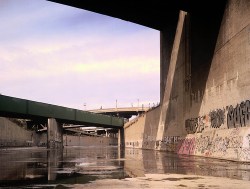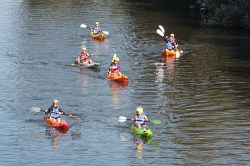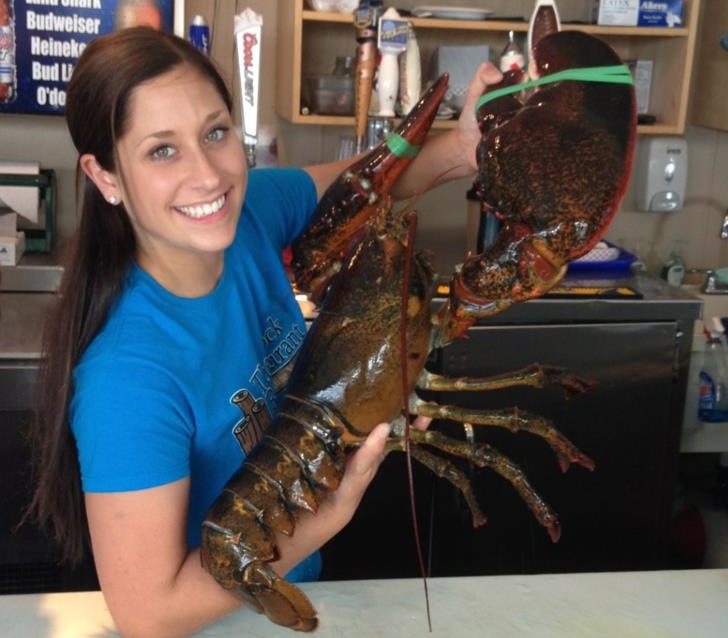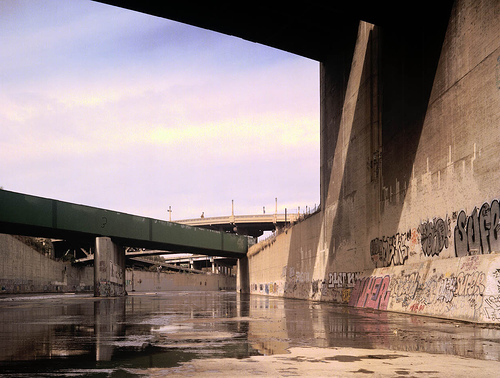
Photo by meltwater.
The Los Angeles River is a character actor, familiar to movie audiences worldwide, even if they don’t know its name. It specializes in the role of apocalyptic battleground, or drag strip, or general stand-in for the paved bleakness of greater Los Angeles. You’ve seen it in Grease, Terminator 2, and T.I.’s “Live Your Life” music video. It’s that wide, paved channel spanned by arched art-deco bridges and power lines.
When it was first paved over in the 1930s, in response to flooding that was threatening the booming city, the Los Angeles River ceased to look like a river, and instead became a simple drainage ditch to speedily convey spring rainfall out of the city’s neighborhoods and into the ocean — a freeway for flash-floodwaters.
For most of the past century, most Angelinos have experienced the river (if at all) as a thin trickle of water running down the middle of a vast concrete channel, a potent example of the city’s defiance and control of nature, and an emblem of everything that environmentalists love to hate about the City of Angels.
But even though government engineers spent the better part of the 20th century putting the river and its tributaries into concrete channels, ditches, and pipes, there still remain surprising patches, often in unlikely places, where the wild Los Angeles River still survives.
 And increasingly, activists and public officials are looking to protect those places, increase public access, and restore the river’s traditional ecological functions. There’s more and more hope that, instead of being the butt of jokes, the Los Angeles River could become a point of pride for the city.
And increasingly, activists and public officials are looking to protect those places, increase public access, and restore the river’s traditional ecological functions. There’s more and more hope that, instead of being the butt of jokes, the Los Angeles River could become a point of pride for the city.
From the suburbs of the San Fernando Valley near the river’s headwaters to the bustling Port of Long Beach at the river’s mouth, the Los Angeles connects diverse neighborhoods in a huge urban watershed that might someday give the sprawling city a stronger sense of ecological identity.
In last year’s movie Drive, there’s a scene where Ryan Gosling drives his neighbor and her son along the paved bed of the Los Angeles River near the Sepulveda Basin Recreation Area. At first, it looks like another example of the old muscle-car movie cliché. But then the car slows and arrives at the end of the concrete, beyond which the river meanders through an overgrown thicket. Gosling and Carey Mulligan (along with the young Kaden Leos) get out of the car and wander into the cottonwoods and willows, where they make eyes at each other in the dewy light next to the babbling water. (You can see them in action below.)
It’s a cute scene, but it also reflects Angelinos’ changing attitudes toward the river — it’s no longer just a drainage ditch you can drive in; it’s a drainage ditch interspersed with secret hideaways of wild nature where you get out of the car for a change, walk around, and find something amazing.
Earlier this summer, with local landscape architects, river advocates, and planners as my guides, I spent a week touring the length of the L.A. River and learning about the waterway’s linchpin role in the city’s gradual transformation into a more sustainable, resilient place. Stay tuned …
Next: How sprawl killed the L.A. River.



